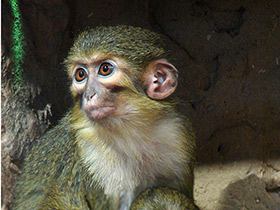The Gabon talapoin (Miopithecus ogouensis), the northern talapoin
The Gabon talapoin (Miopithecus ogouensis), also known as the northern talapoin, is a small species of African monkey native to riparian habitats in Cameroon, Equatorial Guinea, Gabon, the western Republic of the Congo and the far western Democratic Republic of Congo. It may have been introduced to Bioko and the Canary Islands. Classified in the genus Miopithecus, it was given the name Miopithecus ogouensis, based on the River Ogooué, distinguishing it from the other species, the Angolan talapoin, also known as Miopithecus talapoin.
Gabon talapoins are large headed monkeys with yellow-olive tinted coating, and can be differentiated from the Angolan talapoin by its flesh-coloured ears (not blackish). They are always found near watercourses, and are capable of diving and swimming away when disturbed. Males and females live together in mixed groups, but rarely interact with each other outside of mating season. Females tend to give birth annually during the rainy season, with mating season taking place during the dry season. Its diet constitute of mostly foraged fruits, seeds, leaves and insects, and crops raided from cultivated plantations. The Gabon talapoins are dependent on thick coverings to protect them from predation due to their small size, but their elusiveness have also made it difficult to observe their behaviors in the wild.
The Gabon talapoin is considered as Near Threatened on the IUCN Red List of Threatened Species. Assessed in 2017, its overall population trend is decreasing, with a continuing decline of mature individuals. Conservation efforts have been made to preserve its habitat and control trade on an international level.
Taxonomy
The Gabon talapoin is classified under the Cercopithecidae family, and is one of the only two species under the Miopithecus genus, with the other being the lesser known Miopithecus talapoin, also commonly known as the Angolan talapoin.
The Miopithcus genus was considered monotypic until 1969, when Machado suggested there was a northern and southern species separated by the Congo River. The southern species was described as M. talapoin and the northern species was left undescribed. It was not until 1997 that Jonathan Kingdon gave it the scientific name Miopithecus ogouensis, based on the Ogooué River in Gabon. Kingdon pointed out that the presently used binomial, where the specific name is a reference to the Ogooué River, is a nomen nudum:
A nomen nudum, 'Miopithecus ogouensis' is used here in anticipation of a formal description.
However, it can be argued that his description is valid per ICZN rules, as he included an illustration (thereby possibly providing a valid type), a description, and specifically said the name was intended for this new species, leading later authorities to accept it.
Description
Miopithecus ogouensis is a species of catarrhine primate in the family Cercopithecidae.
Miopithecus ogouensis has a pronounced sexual dimorphism: males weigh on average 1380 grams, females 1120 grams. The body length is about 40 cm and the tail length 52.5 cm.
In contrast to the Angolan lesser monkey, the ears and muzzle of this species are flesh-coloured rather than black.
Distribution
Found in the coastal forests of Cameroon, Equatorial Guinea, Gabon, Central African Republic, western Congo and northern Angola (in Cabinda).
Diet and food
Gabon talapoines often forage on the ground, but this type of terrestrial feeding is rarely observed due to their small size and preference for living in dense cover. They tend to feed in sub-groups, with one feeding session in the morning and another in the late afternoon.
Fruits make up almost 80% of the Gabon talapoin's nutrition, with a preference for plums (Uapaca), figs, umbrella tree (Musanga) and mokenjo (Pseudospondias), oil palm nuts and African ginger (Aframomum) fruits. Insects make up about a third of its nutrition, mainly Orthoptera, with occasional beetles, caterpillars and spiders. Seeds and leaves also form part of its nutrition. Banana, papaya and maize plantations are also attractive sources of nutrition for the Gabon talapoin. Close to human settlements, the Gabon talapoin forage for cassava tubers soaked in rivers when other sources of nutrition are scarce. Their nutrition, rich in fruits and insects, also contributes to the ecological balance by dispersing seeds and maintaining insect colonies.
Behaviour
The species inhabits equatorial coastal forests and swamps. Does not stray more than 500 m from riverbanks. Able to swim and dive. Forages on the ground. Diet consists mainly of fruit (about 80% of its diet). Sometimes includes beetles, caterpillars and spiders in its diet.
Conservation status
The Gabon talapoin is facing an overall decreasing population trend and was last assessed as Near Threatened on the IUCN Red List of Threatened Species in 2017. In its previous assessment in 2008, it had a stable population trend and was assessed as Least Concern with no significant threats.
Gabon talapoins were widespread and groups were often associated with villages in Gabon in the 1960s, but some groups have been disappearing. The decline in mature individuals have been attributed to increasing hunting activity. Owing to their small size and low meat yield, Gabon talapoins are difficult to catch and not typical hunting targets. However, the overhunting of larger animals has caused a shift in target and an increase in the hunting and trapping of smaller mammals like the Gabon talapoin. At least twenty-nine Gabon talapoins were impounded in Spain between 2002 and 2006. The monkeys were purchased from local hunters, smuggled into Europe, and have been offered by dealers in Belgium and the Czech Republic. Diet related diseases have been reported in captive talapoins.
Conservation sites across its range have been put in place to protect the land and water. On the level of legislation and trade control, the Gabon talapoin is listed (as the northern talapoin) under the Convention on International Trade of Endangered Species of Wild Fauna and Flora Appendix II, and as Class B under the African Convention.










































